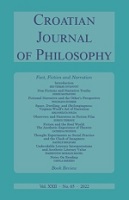Space, Dwelling, and (Be)longingness: Virginia Woolf’s Art of Narration
Space, Dwelling, and (Be)longingness: Virginia Woolf’s Art of Narration
Author(s): Małgorzata HołdaSubject(s): Aesthetics, Contemporary Philosophy, Hermeneutics, Theory of Literature, British Literature, Sociology of Literature
Published by: KruZak
Keywords: Dwelling; narrative; space; Heidegger; Woolf; philosophical hermeneutics;
Summary/Abstract: The supple and ever-present search for the possibilities offered by the narrative form in fictional writing corresponds to the use of the narrative as a mode of understanding and explaining our being-in-the-world in philosophy. The intimate liaison between the realm of fictional imagination and that of human everydayness inspires writers to seek ways to tackle issues of temporality, the conflicting character of human drives, and the ultimately unresolvable tension between finitude and infinitude. As a literary and philosophical category, the narrative remains an inexhaustible space for the exploration of the way we understand our lives. I propose a hermeneutic investigation of the interactions between the art of narration and the categories of space, presence/absence, and (be)- longingness as evoked in Virginia Woolf’s Mrs. Dalloway. This article engages Martin Heidegger’s hermeneutics of facticity, and, more specifically, his notions of homelessness and homecoming, to shed light on the inimitable character of Woolf’s artistic representations of the spatial dimension of human existence, reality viewed as both tremulous and solid, as well as of human embodiment and the disparity/closeness between the corporeal and the spiritual.
Journal: Croatian Journal of Philosophy
- Issue Year: XXII/2022
- Issue No: 65
- Page Range: 181-200
- Page Count: 20
- Language: English

